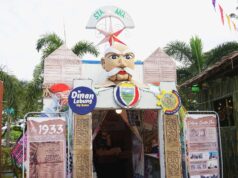KAKAMAL-KAMALAN a aldo. Good Friday – the holiest of days, the day Christ died on the cross, a culminating highlight in the salvation of man. Faith and tradition require from the Christian faithful the most solemn observance of the day.
The way Good Friday, and for that matter, all the other days of the Holy Week, is observed hereabouts is everything but solemn though.
Take the actual crucifixion of penitents in San Pedro Cutud, San Fernando. What solemnity can be found in the circus there? The curious, the tourists, the fanatics, the media, even the born-again and dead-again shove, push and pause to get the best vantage points around the mound that makes a mockery of Calvary.
And where there are crowds, can the noisy mani-mani, balut, halu-halo, buko and ice candy vendors be far behind?
More commercial enterprises there with enterprising organizers selling choice viewing places mostly to dollar-paying foreign tourists who in the sweltering heat invariably come in sweaty, scanty dresses. Lending the atmosphere of a rock concert to what is supposed to be a religious affair.
Still in San Pedro Cutud. Fasting and abstinence for the day which the Church imposes is altogether disregarded. Why, the day is the fiesta of the barangay too.
In the late ‘80s, I did not fail to come to the San Pedro Cutud crucifixion rites as I was required to cover it for the Journal Group of publications, notably People’s Tonight, as well as for the Associated Press. It became a practice for us Pampanga-based mediamen to host our Manila-based peers including those in the wire services for the day. Invariably, we had our lunch at the home of Mayor Paterno S. Guevarra in the adjacent barangay Sta. Lucia.
A devout Catholic who was a perennial lector on the Las Siete Palabras (The Seven Last Words) in some churches, Mayor Pat’s handaan abstained from meat and poultry. It always consisted of fish and seafoods. So we mediamen practiced the requisite abstinence for the day. But did we ever fast? Dummy, will fasting ever comes to mind with succulent crabs and prawns, fresh oysters and baked mussels, grilled squids and all sorts of fish on the banquet table?
All these made one think if Good Friday were really a Christian holy day and not one dedicated to Bacchus or Dionysius.
Holy Wednesday and Maundy Thursday are traditionally the days for Pabasa, the singing of the Passion of Christ. The singing has of late ranged from the rock and the rap to the ridiculous. How else explain this line, “nang si Hudas ay magbigte sa puno ng kamatsile…(When Judas hanged himself on a camachile tree).” Is there such a tree species in all of Palestine, pray, tell me.
At the puni, the place where the Pabasa is held, food – usually ice cream with barquillos, native cakes and coffee, or pineapple juice and biscuits — is also served. Around the puni are the usual makeshift kiosks and lean-to’s serving beer and gin. And there are always what DWRW’s Deng Pangilinan call “puni beauties” or barrio lasses who wait on these establishments.
Even the visita iglesia, the visitation of at least seven churches where the Blessed Sacrament is exposed, has come into some sort of art and décor competition. With the visitors’ interest more on the monumento, the backdrop to the Blessed Sacrament, than on the Body of Christ there. Witness the flash of cameras and the buzz of video recorders. So who still pray there?
It truly makes one wonder. What has become of our observance of the Holy Week?
Really now, the days are right for reflection, repentance and renewal. Magnilay. Mag-isip. Magsisi. Magtika. Magbago.
THAT WAS written in The Voice, March 28-April 3, 1999 issue. Ten years hence, so what has changed with our observance of the Holy Week?
The way Good Friday, and for that matter, all the other days of the Holy Week, is observed hereabouts is everything but solemn though.
Take the actual crucifixion of penitents in San Pedro Cutud, San Fernando. What solemnity can be found in the circus there? The curious, the tourists, the fanatics, the media, even the born-again and dead-again shove, push and pause to get the best vantage points around the mound that makes a mockery of Calvary.
And where there are crowds, can the noisy mani-mani, balut, halu-halo, buko and ice candy vendors be far behind?
More commercial enterprises there with enterprising organizers selling choice viewing places mostly to dollar-paying foreign tourists who in the sweltering heat invariably come in sweaty, scanty dresses. Lending the atmosphere of a rock concert to what is supposed to be a religious affair.
Still in San Pedro Cutud. Fasting and abstinence for the day which the Church imposes is altogether disregarded. Why, the day is the fiesta of the barangay too.
In the late ‘80s, I did not fail to come to the San Pedro Cutud crucifixion rites as I was required to cover it for the Journal Group of publications, notably People’s Tonight, as well as for the Associated Press. It became a practice for us Pampanga-based mediamen to host our Manila-based peers including those in the wire services for the day. Invariably, we had our lunch at the home of Mayor Paterno S. Guevarra in the adjacent barangay Sta. Lucia.
A devout Catholic who was a perennial lector on the Las Siete Palabras (The Seven Last Words) in some churches, Mayor Pat’s handaan abstained from meat and poultry. It always consisted of fish and seafoods. So we mediamen practiced the requisite abstinence for the day. But did we ever fast? Dummy, will fasting ever comes to mind with succulent crabs and prawns, fresh oysters and baked mussels, grilled squids and all sorts of fish on the banquet table?
All these made one think if Good Friday were really a Christian holy day and not one dedicated to Bacchus or Dionysius.
Holy Wednesday and Maundy Thursday are traditionally the days for Pabasa, the singing of the Passion of Christ. The singing has of late ranged from the rock and the rap to the ridiculous. How else explain this line, “nang si Hudas ay magbigte sa puno ng kamatsile…(When Judas hanged himself on a camachile tree).” Is there such a tree species in all of Palestine, pray, tell me.
At the puni, the place where the Pabasa is held, food – usually ice cream with barquillos, native cakes and coffee, or pineapple juice and biscuits — is also served. Around the puni are the usual makeshift kiosks and lean-to’s serving beer and gin. And there are always what DWRW’s Deng Pangilinan call “puni beauties” or barrio lasses who wait on these establishments.
Even the visita iglesia, the visitation of at least seven churches where the Blessed Sacrament is exposed, has come into some sort of art and décor competition. With the visitors’ interest more on the monumento, the backdrop to the Blessed Sacrament, than on the Body of Christ there. Witness the flash of cameras and the buzz of video recorders. So who still pray there?
It truly makes one wonder. What has become of our observance of the Holy Week?
Really now, the days are right for reflection, repentance and renewal. Magnilay. Mag-isip. Magsisi. Magtika. Magbago.
THAT WAS written in The Voice, March 28-April 3, 1999 issue. Ten years hence, so what has changed with our observance of the Holy Week?




